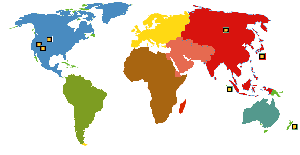Mount St. Helens was tiny compared to the most dangerous type of volcano, the super volcano – like Yellowstone located in the Yellowstone National Park of Wyoming. Try to imagine an eruption that could be up to 10,000 times stronger than a Mount St. Helens… an eruption that would threaten the very survival of all humankind. The super volcano is quite likely the worst case scenario of any and all possible disaster scenarios, in my opinion, mainly due to its sheer magnitude of devastation. It’s devastation ranks up there with a large asteroid hit, world nuclear war, and world wide deadly pandemic. There is absolutely nothing that we can do to prevent it and it makes no sense to worry about it, although it may encourage some to ‘prepare’ beyond just a few weeks or months. We’re talking years…

image source: National Geographic
Super Volcano Effects
- Magma would be hurled 30 miles up into the atmosphere
- Complete devastation of an area the size of North America or Europe
- Volcanic ash would cover the devastated area to depths ranging from hundreds of feet to as much as six inches – thousands of miles away
- Anything within 500 miles of the eruption would be completely destroyed
- Sunlight would be blotted out for months followed by a dim and cold volcanic winter lasting for several years
- Global temperature would drop 20 degrees
- Mini Ice Age
- 75% of all plant species would die off
- World agriculture would be devastated
- Mass starvation
- The very survival of human civilization would be threatened
Super Volcano locations include…
- Yellowstone in Wyoming (USA)
- Long Valley in California (USA)
- Valley Grande in New Mexico (USA)
- Lake Taupo in New Zealand
- Aira in Japan
- Lake Toba in Sumatra
- Siberian Traps in Russia

A somewhat alarming statistic regarding Yellowstone is that it’s eruption cycle is as short as 600,000 years and as long as 800,000 years. The last eruption was 640,000 years ago, and we are now within the time frame of possibility (40,000 years beyond it!) while we may also never witness it in our lifetime.
When considering the effects that such an event would have upon the world, it is nearly incomprehensible to create a survival plan. When considering Yellowstone for example, those that live in Idaho, Montana, and Wyoming will have a terrible if not impossible chance of survival. Much of the United States will be covered with ash, probably at a minimum depth of 5 inches while much deeper the closer one is to ground zero (many feet to 10′s of feet deep).
To put the amount of ash into perspective, the amount of ash and ejecta from Yellowstone could be as much as 11,000,000,000,000 cubic meters (11 trillion), which is equivalent to 2,600 cubic miles. Visualize flying at cruising altitude in a jetliner… and imagine looking out the window all around you for 20 miles in each direction. Then imagine that space filled up to the height you are flying (apprx. 30,000′ altitude). It’s mind boggling.
How could one expect a chance to survive the effects of such a catastrophe? You may decide that it’s not worth the effort due to the magnitude of such an event coupled with the low probability. If you live within several hundred miles of Yellowstone you don’t stand a chance to survive anyway. However there is always hope and a way for those living further away.
A key factor to surviving a super volcano begins with living far away from it (common sense), having several years of food (and a water source with a means of filtering), and the supplies and skills to grow your own food when the earth finally allows it once again after the ‘nuclear winter’ has subsided. Most probably will not survive such an event, but even so, it’s worth a few minutes contemplation while knowing that these events do occur and will occur again. It may motivate some of you.
Appreciate topics of survival, emergency preparedness – or planning for disaster?
Read our current articles on Modern Survival Blog
twitter: MSurvivalBlog
Facebook